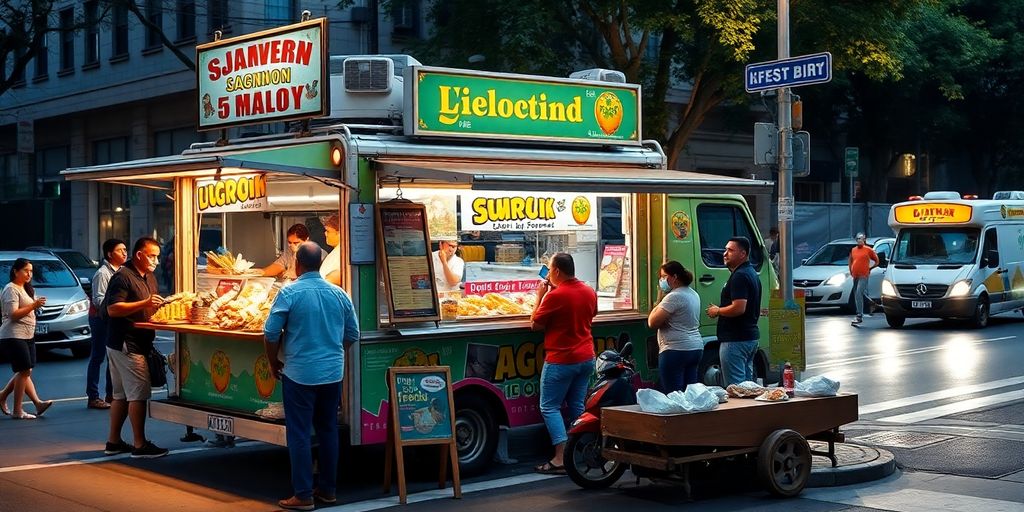So, you’re running a food truck and want to get more eyes on your business? Well, SEO, or search engine optimization, might just be your new best friend. It’s all about making sure people can find you online, especially when they’re searching for local eats. From mobile-friendly sites to engaging content, there’s a lot you can do to boost your visibility. Let’s dive into what SEO for food trucks really means and how you can use it to your advantage.
Key Takeaways
- SEO is crucial for food trucks to stand out online and attract local customers.
- A mobile-friendly website is essential, as many customers search on-the-go.
- Local SEO strategies, like Google My Business, help improve visibility.
- Engaging content and social media can draw in more customers.
- Regularly monitoring SEO performance ensures strategies are effective.
Understanding SEO for Food Trucks
Defining SEO in the Food Truck Context
SEO, or Search Engine Optimization, is all about making your food truck visible online. In the food truck world, this means ensuring that when someone nearby searches for a tasty bite, your truck pops up in their results. This visibility is crucial for attracting new customers who might not know about you otherwise. It’s not just about keywords but also about how your website performs, especially on mobile devices.
Importance of Local SEO
Local SEO is like the secret sauce for food trucks. It focuses on making sure your business shows up in local searches, like "tacos near me" or "best food truck in town." This involves optimizing your Google My Business listing, gathering positive reviews, and making sure your location details are accurate. Local SEO ensures that your truck is easy to find when folks are hungry and nearby.
How SEO Impacts Visibility
SEO directly affects how often and where your food truck appears in search results. A well-optimized site can mean the difference between being on the first page of Google or being buried in the search results. With effective SEO strategies, your food truck can stand out in a crowded market, attracting more customers and boosting sales.
Optimizing your online presence is not just about being found; it’s about being chosen. When your food truck is easy to find online, it becomes the go-to spot for people eager to try something new.
Building a Mobile-Friendly Website
Why Mobile Optimization Matters
In today’s fast-paced world, most people are glued to their smartphones. This means your food truck’s website needs to be mobile-friendly. If your site is slow or hard to use on a phone, people will just move on to another option. Google even ranks mobile-friendly sites higher, so it’s crucial for your search visibility. Imagine someone hungry, looking for a quick bite—they’re not going to wait around for a slow site to load.
Key Features of a Mobile-Friendly Site
Creating a mobile-friendly website involves a few key features:
- Responsive Design: Your site should automatically adjust to fit any screen size, whether it’s a phone, tablet, or desktop.
- Fast Load Times: Aim for your site to load in under three seconds. Slow sites lose visitors fast.
- Easy Navigation: Make sure menus are simple and buttons are big enough to tap easily.
Testing Your Mobile Site
Once your site is set up, it’s important to test it. Use tools like Google’s Mobile-Friendly Test to see how your site performs. Also, try browsing your site on different devices to catch any issues. Regular testing helps ensure your site stays user-friendly.
A mobile-friendly website isn’t just a nice-to-have anymore; it’s a must-have. With more people browsing on phones, your food truck’s online presence depends on it.
Utilizing Local SEO Strategies

Claiming Your Google My Business Listing
First things first, if you haven’t claimed your Google My Business (GMB) listing, you’re missing out big time. This is your ticket to appearing in local search results and Google Maps. By claiming and optimizing your GMB listing, you’re essentially putting your food truck on the map—literally. Make sure to fill out all the details like your location, hours, menu, and photos. Keeping this info up-to-date is crucial for attracting local customers.
Optimizing for Local Keywords
When it comes to keywords, think local. Use tools like Google’s Keyword Planner to find out what folks in your area are searching for. Sprinkle these local keywords throughout your website, from your homepage to your blog posts. You want to make sure that when someone searches for "food truck tacos near me," your truck pops up.
Engaging with Local Directories
Don’t underestimate the power of local directories. Sites like Yelp, TripAdvisor, and even local business directories can boost your visibility. List your food truck on these platforms and encourage happy customers to leave reviews. This not only improves your SEO but also builds trust with potential customers.
Local SEO isn’t just about being found—it’s about being found by the right people, right when they’re looking for you. Keep your information accurate, engage with your community, and watch your customer base grow.
Creating Engaging Content
Types of Content That Attract Customers
Creating content isn’t just about filling your website with words. It’s about crafting the kind of material that draws in your audience. For food trucks, this means focusing on mouth-watering descriptions of your dishes, behind-the-scenes stories, and maybe even a blog about your food truck journey. Eye-catching photos of your food can make a huge difference. People eat with their eyes first, right? So, get those stunning shots of your top dishes and post them everywhere!
Using Social Media for Content Promotion
Social media is your best buddy when it comes to promoting your content. Platforms like Instagram and Facebook are perfect for showcasing your food truck’s personality and delicious offerings. Share stories, engage with followers, and keep the conversation going. Consistency is key here; regular posts keep your audience engaged and coming back for more. You can even run contests or giveaways to boost interaction.
The Role of Customer Reviews
Customer reviews can be your best advertisement. Encourage your happy customers to leave reviews on Yelp or Google. These reviews not only help bring in new customers but also improve your online reputation. Responding to reviews, whether positive or negative, shows that you care about your customers’ feedback and are willing to make improvements. This interaction builds trust and encourages more people to try out your food truck.
Monitoring SEO Performance

Conducting Regular SEO Audits
Keeping an eye on your SEO efforts is like checking your car’s oil—it’s essential. Regular SEO audits help you see how well your food truck’s online presence is doing. An audit can uncover issues that might be holding you back, like slow page speeds or broken links. Use tools like Google Search Console and Ahrefs to spot these problems. They can help you tweak your strategy and keep everything running smoothly.
Key Metrics to Track
When you’re managing SEO, some numbers really matter. Here’s what you should keep an eye on:
- Organic Traffic: This shows how many people find your site through search engines.
- Conversion Rate: Are visitors taking the actions you want, like signing up for a newsletter?
- Bounce Rate: This tells you how many visitors leave after viewing just one page.
Tracking these metrics helps you understand what’s working and what needs fixing.
Tools for SEO Analysis
There are loads of tools out there, but not all are created equal. Here are a few you might consider:
- SEMRush: Great for a deep dive into your traffic and keyword performance.
- Moz: Offers insights into your site’s authority and keyword rankings.
- Google Analytics: A must-have for tracking user behavior and site performance.
Keeping tabs on your SEO performance is a bit like maintaining your food truck—regular check-ups can prevent bigger problems down the road.
For more tips on building a loyal customer base and boosting your food truck business, check out our comprehensive marketing guide.
Leveraging Social Media for SEO
Building a Social Media Presence
Building a strong social media presence is like setting up shop in a bustling town square. It’s where your food truck can really shine. Start by choosing platforms that fit your brand. Facebook, Instagram, and Twitter are great places to begin. Make sure your profiles are complete with your logo, a catchy bio, and all the necessary contact info. Consistent posting is key. Share photos of your food, updates on your location, and any special events.
Engaging with Your Audience
Engagement isn’t just about posting content—it’s about interaction. Respond to comments and messages quickly. Ask your followers questions and encourage them to share their thoughts. This two-way communication not only builds community but also boosts your visibility. Engagement metrics, like likes and shares, can help increase your reach, making your food truck more discoverable online.
Using Social Media for Promotions
Social media is a powerful tool for running promotions. Consider offering discounts or hosting giveaways to attract more followers. Create limited-time offers that encourage immediate action. A well-timed promotion can create a buzz around your food truck, driving foot traffic and enhancing your online presence. Remember to track the performance of these promotions to see what works best.
The Importance of Customer Engagement
Encouraging Customer Feedback
Getting feedback from your customers isn’t just about collecting reviews; it’s about building a relationship. When you openly ask for feedback, you’re telling your customers their opinions matter. This openness can lead to more trust and loyalty. You can encourage feedback by asking customers to share their thoughts on platforms like Google My Business or Yelp. A simple sign at your food truck or a friendly reminder when serving customers can go a long way. Make sure to also pay attention to the feedback you receive and show that you’re willing to make improvements.
Responding to Reviews
Engaging with reviews, both good and bad, is crucial. Responding to positive reviews is a great way to say thanks and show appreciation. But don’t shy away from negative reviews. Address them promptly and professionally. This shows potential customers that you care about their experience and are committed to improving. Engagement with reviews can enhance your online reputation, which in turn boosts your SEO. Plus, it gives you a chance to turn a negative experience into a positive one.
Building a Community Around Your Brand
Creating a community isn’t just about having a social media presence; it’s about making connections. Start by engaging with your audience on platforms like Facebook or Instagram. Share behind-the-scenes photos, host live Q&A sessions, or even create a hashtag for your food truck. You could also consider hosting events or collaborations with other local businesses. Building a community helps in creating a loyal customer base that feels personally connected to your brand. And remember, a strong community can drive word-of-mouth marketing, which is powerful for any business.
Building a community around your brand is like planting seeds for future growth. The more you nurture these connections, the more your brand will flourish.
Wrapping It Up: SEO for Food Trucks
So there you have it, folks. SEO isn’t just for the big guys anymore; it’s a game-changer for food trucks too. With a little effort, you can boost your visibility and draw in more hungry customers. From making sure your website is mobile-friendly to using the right keywords, these strategies can really make a difference. And don’t forget about social media—it’s a great way to connect with your audience and keep them coming back for more. So, get out there, tweak your online presence, and watch your food truck business grow. It’s not rocket science, but it does take some work. Good luck, and happy serving!
Frequently Asked Questions
What is SEO and how does it help a food truck?
SEO stands for Search Engine Optimization. It’s a way to make your food truck show up more in online searches. It helps people find your truck when they search for food options nearby.
Why is local SEO important for food trucks?
Local SEO helps your food truck appear in searches made by people in your area. It makes it easier for local customers to find you, which can increase sales.
How can I make my food truck’s website mobile-friendly?
To make your website mobile-friendly, ensure it loads quickly and looks good on small screens. You can use tools like Google’s mobile-friendly test to check your site.
What type of content should I create for my food truck?
You can create content like blog posts about your menu, videos of your cooking process, or updates about your truck’s location. Engaging content can attract more customers.
How can I use social media to boost my food truck’s SEO?
Share updates, photos, and promotions on social media to reach more people. Engaging with your audience on platforms like Instagram or Facebook can drive more traffic to your website.
How do I track my food truck’s SEO performance?
Use tools like Google Analytics to see how many people visit your site and what they do there. Regularly check these metrics to understand how well your SEO is working.






